high beam TOYOTA CAMRY 2018 Owners Manual (in English)
[x] Cancel search | Manufacturer: TOYOTA, Model Year: 2018, Model line: CAMRY, Model: TOYOTA CAMRY 2018Pages: 612, PDF Size: 10.63 MB
Page 3 of 612

3
1
8 7 5 4
3
2
CAMRY_U (01999-06139)
9
6
4-2. Driving proceduresEngine (ignition) switch (vehicles without a
smart key system) ........... 198
Engine (ignition) switch (vehicles with a smart
key system) ..................... 200
Automatic transmission ..... 205
Turn signal lever................ 211
Parking brake .................... 212
Electric parking brake........ 213
Brake Hold ........................ 217
4-3. Operating the lights and wipers
Headlight switch ................ 219
Automatic High Beam ....... 223
Windshield wipers and washer ............................ 227
4-4. Refueling Opening the fuel tank cap .................................. 231
4-5. Using the driving support systems
Toyota Safety Sense P ..... 235
PCS (Pre-Collision System) ........................... 242
LDA (Lane Departure Alert with steering
control) ............................ 253
Dynamic radar cruise control with full-speed
range ............................... 263
Dynamic radar cruise control ............................. 276
Cruise control .................... 289
Driving assist systems....... 294 BSM (Blind Spot
Monitor) ........................... 300
• BSM function ................. 304
• RCTA function ............... 306
Rear Camera Detection Function........................... 310
Intuitive parking assist ....... 314
Intelligent Clearance Sonar (ICS) ..................... 322
Driving mode select switches........................... 343
4-6. Driving tips Winter driving tips .............. 345
5-1. Using the air conditioning system and defogger
Manual air conditioning system ............................. 350
Automatic air conditioning system (without “SYNC”
button) ............................. 355
Automatic air conditioning system (with “SYNC”
button) ............................. 361
Seat heaters ...................... 369
5-2. Using the interior lights Interior lights list................. 370
• Interior lights.................. 371
• Personal lights............... 372
5Interior features
Page 16 of 612
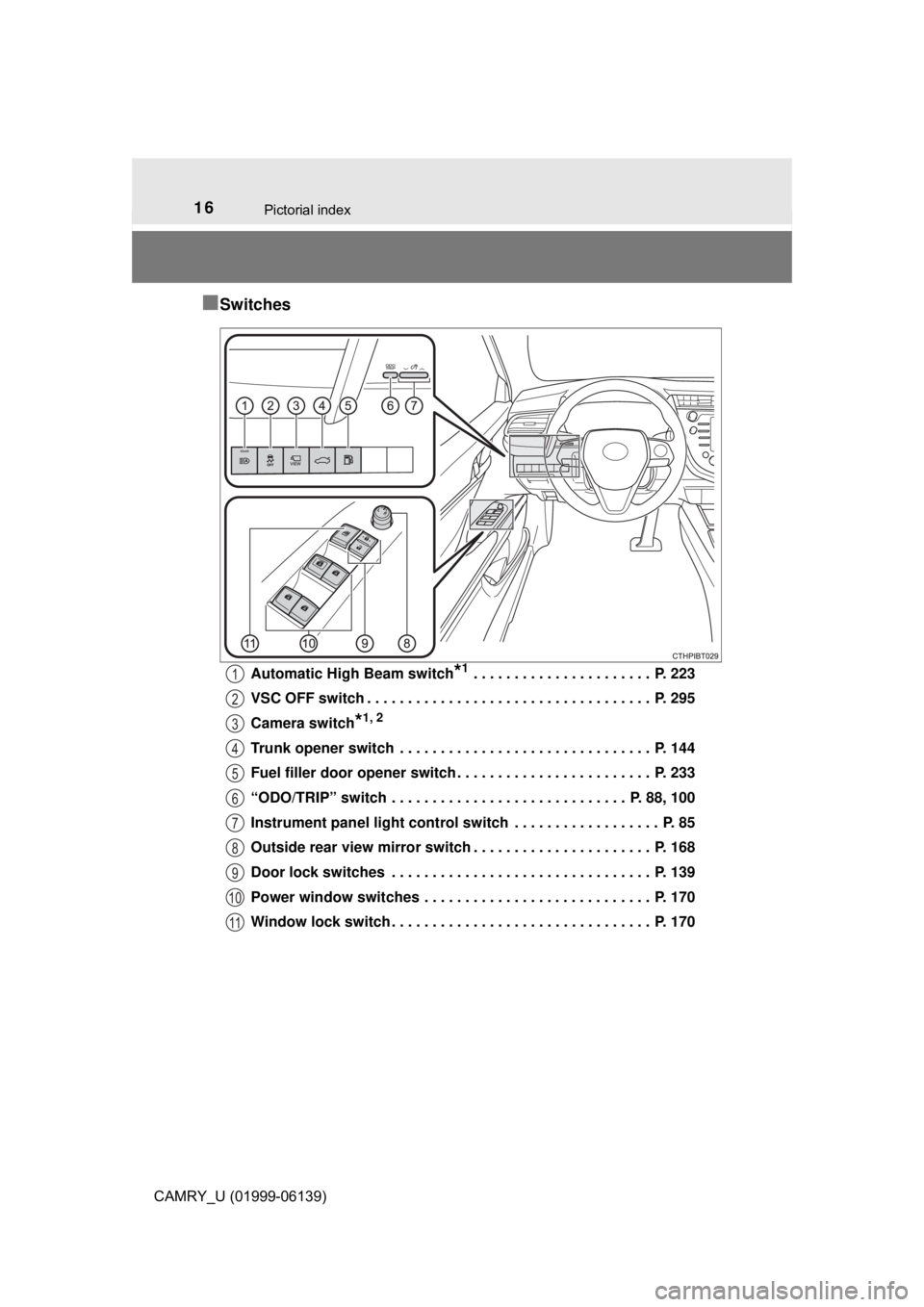
16Pictorial index
CAMRY_U (01999-06139)
■Switches
Automatic High Beam switch*1 . . . . . . . . . . . . . . . . . . . . . . P. 223
VSC OFF switch . . . . . . . . . . . . . . . . . . . . . . . . . . . . . . . . . . . P. 295
Camera switch
*1, 2
Trunk opener switch . . . . . . . . . . . . . . . . . . . . . . . . . . . . . . . P. 144
Fuel filler door opener switch . . . . . . . . . . . . . . . . . . . . . . . . P. 233
“ODO/TRIP” switch . . . . . . . . . . . . . . . . . . . . . . . . . . . . . P. 88, 100
Instrument panel light control switch . . . . . . . . . . . . . . . . . . P. 85
Outside rear view mirror switch . . . . . . . . . . . . . . . . . . . . . . P. 168
Door lock switches . . . . . . . . . . . . . . . . . . . . . . . . . . . . . . . . P. 139
Power window switches . . . . . . . . . . . . . . . . . . . . . . . . . . . . P. 170
Window lock switch . . . . . . . . . . . . . . . . . . . . . . . . . . . . . . . . P. 170
1
2
3
4
5
6
7
8
9
10
11
Page 81 of 612
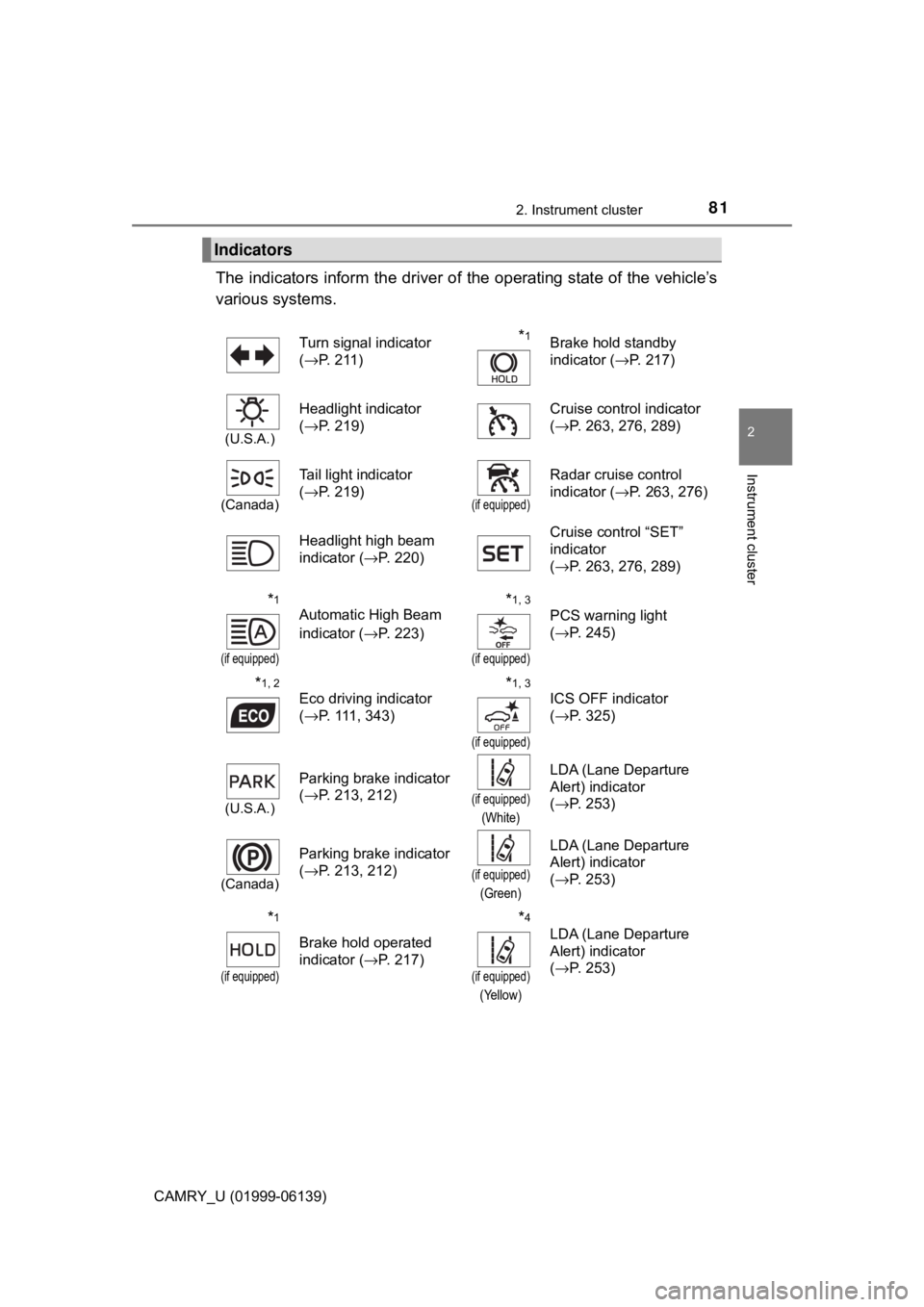
812. Instrument cluster
2
Instrument cluster
CAMRY_U (01999-06139)
The indicators inform the driver of the operating state of the vehicle’s
various systems.
Indicators
Turn signal indicator
( →P. 211)*1Brake hold standby
indicator ( →P. 217)
(U.S.A.)
Headlight indicator
(→P. 219) Cruise control indicator
(
→P. 263, 276, 289)
(Canada)
Tail light indicator
(→P. 219)
(if equipped)
Radar cruise control
indicator ( →P. 263, 276)
Headlight high beam
indicator ( →P. 220) Cruise control “SET”
indicator
(
→P. 263, 276, 289)
*1
(if equipped)
Automatic High Beam
indicator ( →P. 223)*1, 3
(if equipped)
PCS warning light
(→P. 245)
*1, 2
Eco driving indicator
(→P. 111, 343)*1, 3
(if equipped)
ICS OFF indicator
(→P. 325)
(U.S.A.)
Parking brake indicator
(→P. 213, 212)
(if equipped)
(White)
LDA (Lane Departure
Alert) indicator
(→P. 253)
(Canada)
Parking brake indicator
(→P. 213, 212)
(if equipped)
(Green)
LDA (Lane Departure
Alert) indicator
(→P. 253)
*1
(if equipped)
Brake hold operated
indicator ( →P. 217)
*4
(if equipped)
(Yellow)
LDA (Lane Departure
Alert) indicator
(→P. 253)
Page 183 of 612

183
4Driving
CAMRY_U (01999-06139)4-1. Before driving
Driving the vehicle ............. 184
Cargo and luggage ........... 192
Vehicle load limits ............. 195
Trailer towing..................... 196
Dinghy towing ................... 197
4-2. Driving procedures Engine (ignition) switch (vehicles without a
smart key system) ........... 198
Engine (ignition) switch (vehicles with a smart
key system) ..................... 200
Automatic transmission .................... 205
Turn signal lever................ 211
Parking brake .................... 212
Electric parking brake........ 213
Brake Hold ........................ 217
4-3. Operating the lights and wipers
Headlight switch ................ 219
Automatic High Beam ....... 223
Windshield wipers and washer ............................ 227 4-4. Refueling
Opening the fuel tank cap .................................. 231
4-5. Using the driving support systems
Toyota Safety Sense P ..... 235
PCS (Pre-Collision System)........................... 242
LDA (Lane Departure Alert with steering
control) ............................ 253
Dynamic radar cruise control with full-speed
range............................... 263
Dynamic radar cruise control ............................. 276
Cruise control .................... 289
Driving assist systems ...... 294
BSM (Blind Spot Monitor) ........ 300
• BSM function ................ 304
• RCTA function .............. 306
Rear Camera Detection Function .......................... 310
Intuitive parking assist....... 314
Intelligent Clearance Sonar (ICS) ..................... 322
Driving mode select switches .......................... 343
4-6. Driving tips Winter driving tips ............. 345
Page 220 of 612
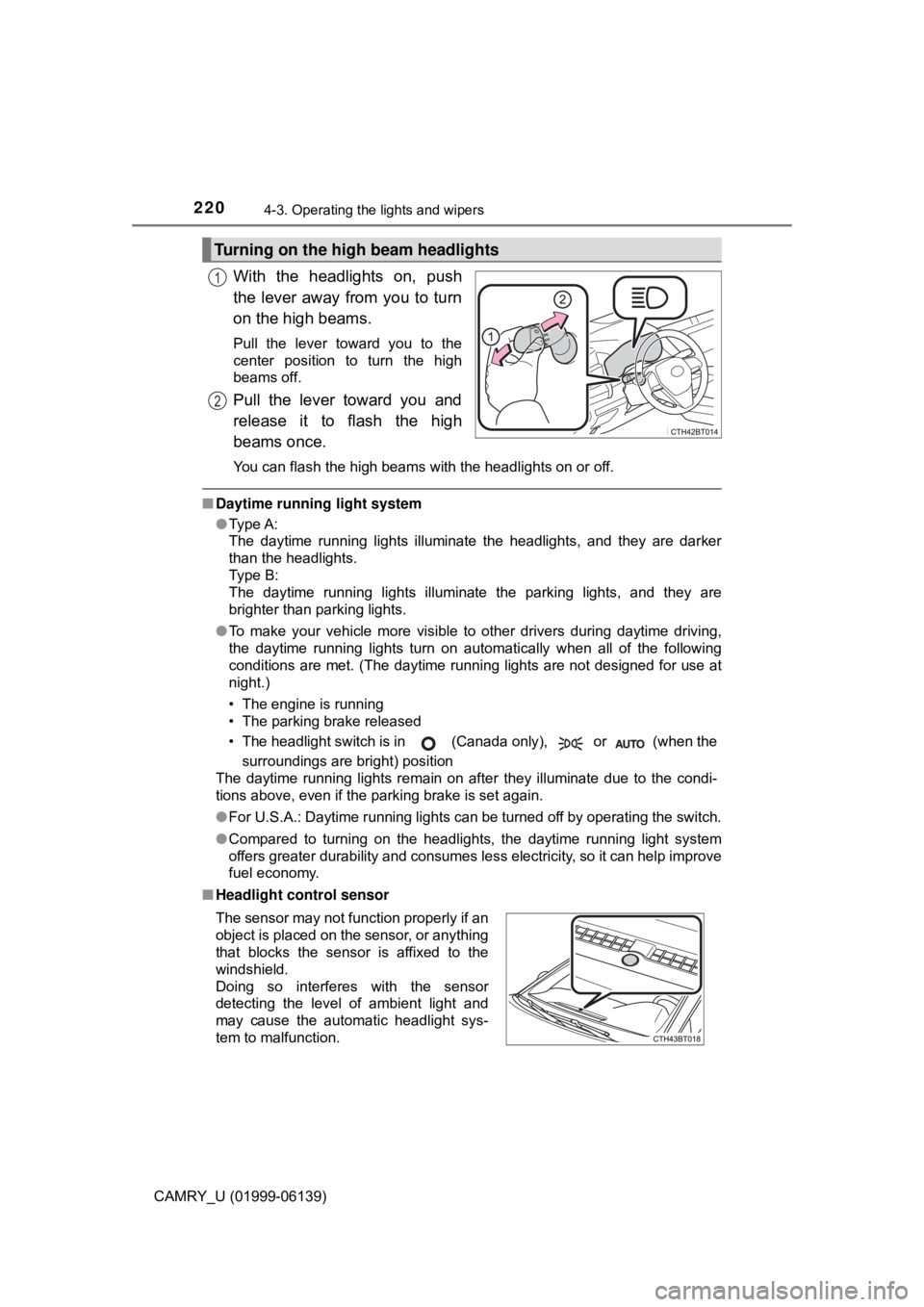
2204-3. Operating the lights and wipers
CAMRY_U (01999-06139)
With the headlights on, push
the lever away from you to turn
on the high beams.
Pull the lever toward you to the
center position to turn the high
beams off.
Pull the lever toward you and
release it to flash the high
beams once.
You can flash the high beams with the headlights on or off.
■Daytime running light system
●Type A:
The daytime running lights illuminate the headlights, and they are darker
than the headlights.
Type B:
The daytime running lights illuminate the parking lights, and they are
brighter than parking lights.
● To make your vehicle more visible to other drivers during daytime driving,
the daytime running lights turn on automatically when all of the following
conditions are met. (The daytime running lights are not designed for use at
night.)
• The engine is running
• The parking brake released
• The headlight switch is in (Canada only), or (when the
surroundings are bright) position
The daytime running lights remain on after they illuminate due to the condi-
tions above, even if the parking brake is set again.
● For U.S.A.: Daytime running lights can be turned off by operating the switch.
● Compared to turning on the headlights, the daytime running light system
offers greater durability and consumes less electricity, so it can help improve
fuel economy.
■ Headlight control sensor
Turning on the high beam headlights
1
2
The sensor may not function properly if an
object is placed on the sensor, or anything
that blocks the sensor is affixed to the
windshield.
Doing so interferes with the sensor
detecting the level of ambient light and
may cause the automatic headlight sys-
tem to malfunction.
Page 223 of 612
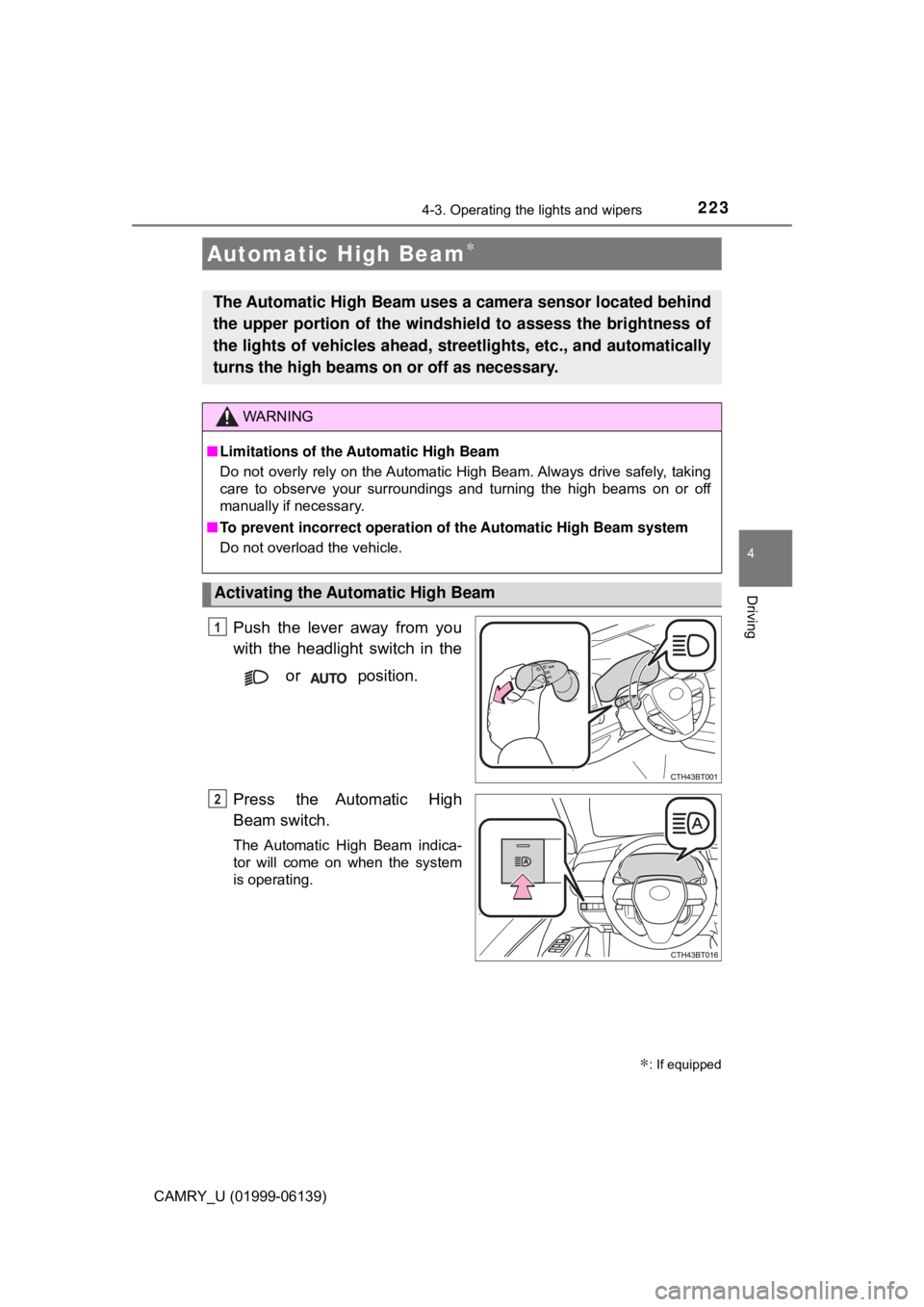
2234-3. Operating the lights and wipers
4
Driving
CAMRY_U (01999-06139)
Push the lever away from you
with the headlight switch in the or position.
Press the Automatic High
Beam switch.
The Automatic High Beam indica-
tor will come on when the system
is operating.
Automatic High Beam∗
The Automatic High Beam uses a camera sensor located behind
the upper portion of the windshiel d to assess the brightness of
the lights of vehicles ahead, streetlights, etc., and automatically
turns the high beams on or off as necessary.
WARNING
■ Limitations of the Automatic High Beam
Do not overly rely on the Automatic High Beam. Always drive safely, taking
care to observe your surroundings and turning the high beams on or off
manually if necessary.
■ To prevent incorrect operation of the Automatic High Beam system
Do not overload the vehicle.
Activating the Automatic High Beam
1
∗: If equipped
2
Page 224 of 612
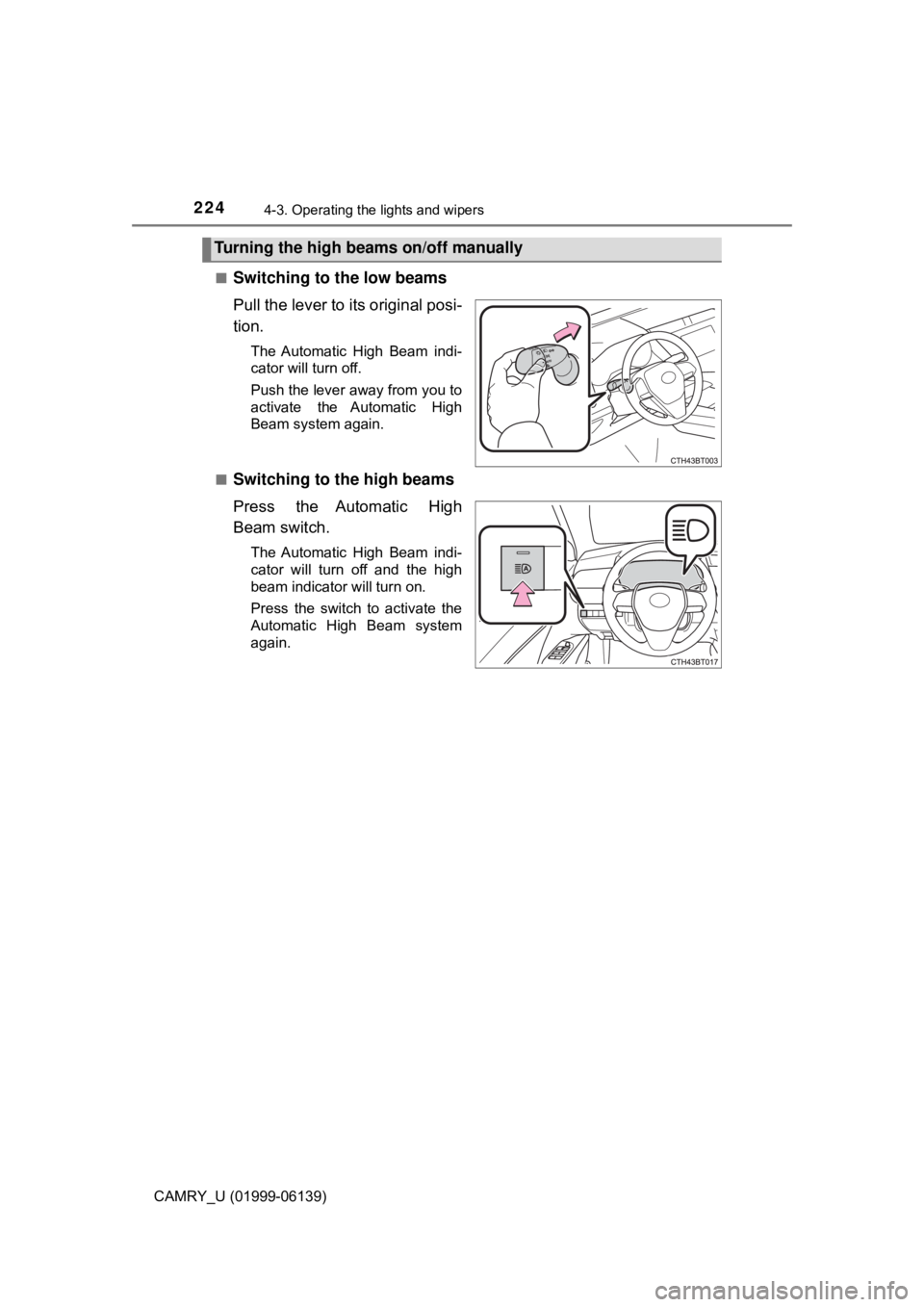
2244-3. Operating the lights and wipers
CAMRY_U (01999-06139)■
Switching to the low beams
Pull the lever to its original posi-
tion.
The Automatic High Beam indi-
cator will turn off.
Push the lever away from you to
activate the Automatic High
Beam system again.
■
Switching to the high beams
Press the Automatic High
Beam switch.
The Automatic High Beam indi-
cator will turn off and the high
beam indicator will turn on.
Press the switch to activate the
Automatic High Beam system
again.
Turning the high beams on/off manually
Page 225 of 612

2254-3. Operating the lights and wipers
4
Driving
CAMRY_U (01999-06139)
■Conditions to turn the high beams on/off automatically
●When all of the following conditions are met, the high beams will be turned
on automatically (after approximately 1 second):
• The vehicle speed is approximately 21 mph (34 km/h) or more.
• The area ahead of the vehicle is dark.
• There are no vehicles ahead with headlights or tail lights turned on.
• There are few streetlights on the road ahead.
● If any of the following conditions is met, the high beams will turn off automat-
ically:
• The vehicle speed is below approximately 17 mph (27 km/h).
• The area ahead of the vehicle is not dark.
• Vehicles ahead have their headlights or tail lights turned on.
• There are many streetlights on the road ahead.
■ Camera sensor detection information
●The high beams may not be automatically turned off in the following situa-
tions:
• When a vehicle suddenly appears from around a curve
• When the vehicle is cut in front of by another vehicle
• When vehicles ahead cannot be detected due to repeated curves, road
dividers or roadside trees
• When vehicles ahead appear in a faraway lane on a wide road
• When the lights of vehicles ahead are not on
● The high beams may be turned off if a vehicle ahead that is using fog lights
without its headlights turned on is detected.
● House lights, street lights, traffic signals, and illuminated billboards or signs
and other reflective objects may cause the high beams to change to the low
beams, or the low beams to remain on.
● The following factors may affect the amount of time taken for the high
beams to turn on or off:
• The brightness of the headlights, fog lights, and tail lights of vehicles
ahead
• The movement and direction of vehicles ahead
• When a vehicle ahead only has operational lights on one side
• When a vehicle ahead is a two-wheeled vehicle
• The condition of the road (gradient, curve, condition of the road surface, etc.)
• The number of passengers and amount of luggage in the vehicle
● The high beams may turn on or off unexpectedly.
● Bicycles or similar vehicles may not be detected.
Page 226 of 612

2264-3. Operating the lights and wipers
CAMRY_U (01999-06139)●
In the following situations the system may not be able to correctly detect the
surrounding brightness level. This may cause the low beams to remain on
or the high beams to flash or dazzle pedestrians or vehicles ahead. In such
a case, it is necessary to manually switch between the high and low beams.
• When driving in inclement weather (heavy rain, snow, fog, sandstorms,
etc.)
• When the windshield is obscured by fog, mist, ice, dirt, etc.
• When the windshield is cracked or damaged
• When the camera sensor is deformed or dirty
• When the temperature of the camera sensor is extremely high
• When the surrounding brightness level is equal to that of headlights, tai\
l lights or fog lights
• When headlights or tail lights of vehicles ahead are turned off, dirty,
changing color, or not aimed properly
• When the vehicle is hit by water, snow, dust, etc. from a preceding vehi- cle
• When driving through an area of in termittently changing brightness and
darkness
• When frequently and repeatedly driving ascending/descending roads, or
roads with rough, bumpy or uneven surfaces (such as stone-paved
roads, gravel roads, etc.)
• When frequently and repeatedly taking curves or driving on a winding
road
• When there is a highly reflective object ahead of the vehicle, such as a sign or mirror
• When the back of a preceding vehicle is highly reflective, such as a con- tainer on a truck
• When the vehicle's headlights are damaged or dirty, or are not aimed properly
• When the vehicle is listing or titling due to a flat tire, a trailer being towed,
etc.
• When the headlights are changed between the high beams and low beams repeatedly in an abnormal manner
• When the driver believes that the high beams may be flashing or dazzling pedestrians or other drivers
■ Temporarily lowering sensor sensitivity
The sensitivity of the sensor can be temporarily lowered.
Turn the engine switch off while the following conditions are met.
• The headlight switch is in .
• The headlight switch lever is in high beam position.
Turn the engine switch to the “ON” position (vehicles without a smart key
system) or IGNITION ON mode (vehicles with a smart key system).
Within 5 seconds after , repeat pulling the headlight switch lever to the
original position then pushing it to the high beam position quickly 9 times,
then leave the lever in high beam position.
Automatic High Beam (headlights) may turn on even when the vehicle is
stopped.
1
2
32
Page 235 of 612
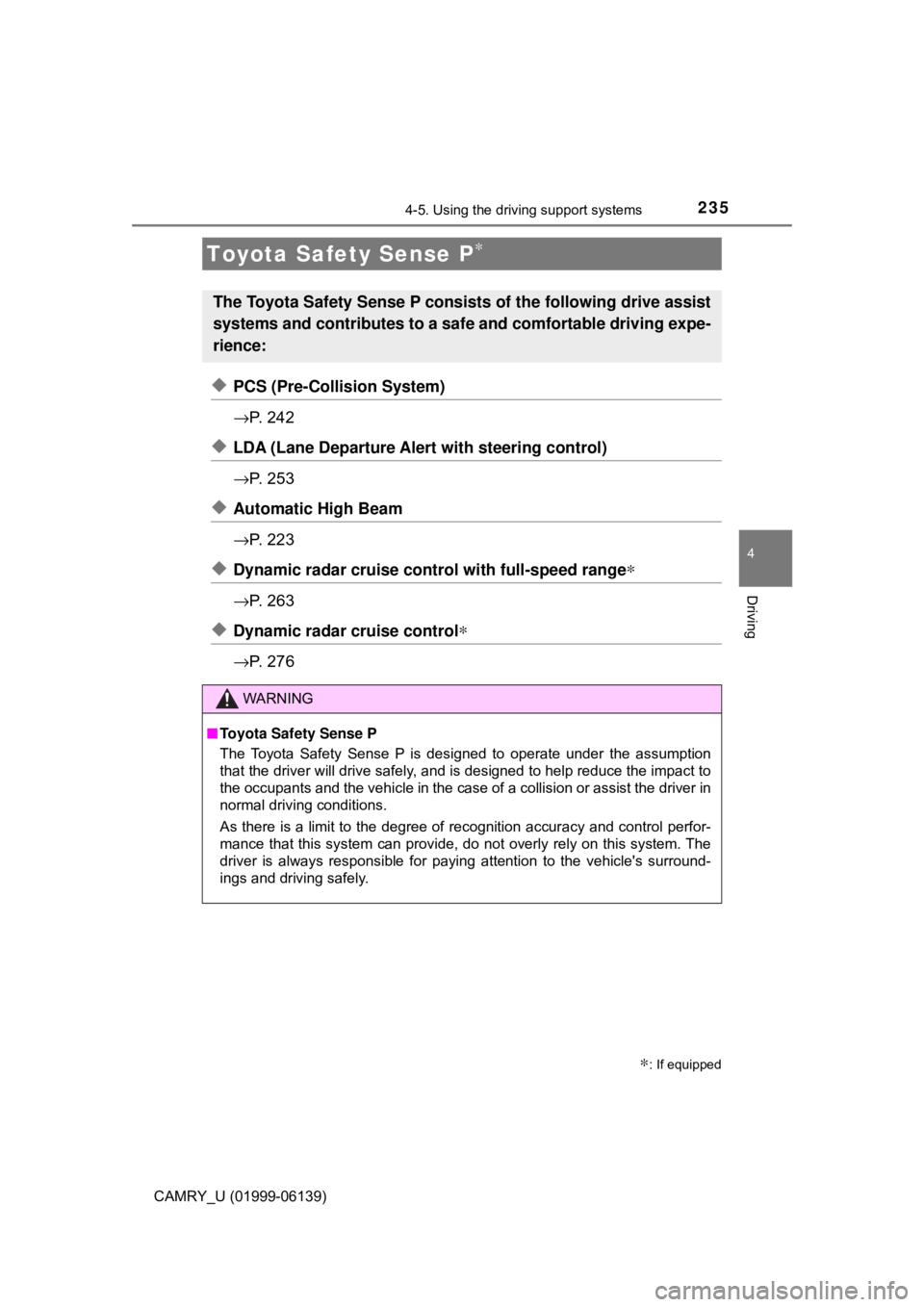
235
4
Driving
CAMRY_U (01999-06139)
4-5. Using the driving support systems
◆PCS (Pre-Collision System)
→P. 2 4 2
◆LDA (Lane Departure Alert with steering control)
→P. 2 5 3
◆Automatic High Beam
→P. 2 2 3
◆Dynamic radar cruise cont rol with full-speed range∗
→P. 2 6 3
◆Dynamic radar cruise control∗
→P. 2 7 6
Toyota Safety Sense P∗
∗: If equipped
The Toyota Safety Sense P consists of the following drive assist
systems and contributes to a safe and comfortable driving expe-
rience:
WARNING
■Toyota Safety Sense P
The Toyota Safety Sense P is designed to operate under the assumption
that the driver will drive safely, and is designed to help reduce the impact to
the occupants and the vehicle in the case of a collision or assist the driver in
normal driving conditions.
As there is a limit to the degree of recognition accuracy and control perfor-
mance that this system can provide, do not overly rely on this system. The
driver is always responsible for paying attention to the vehicle's surround-
ings and driving safely.